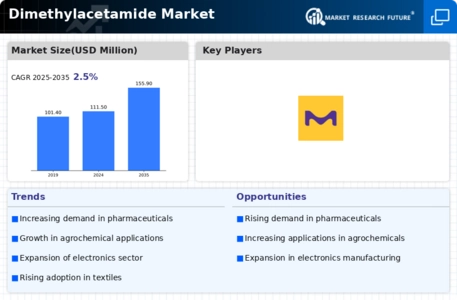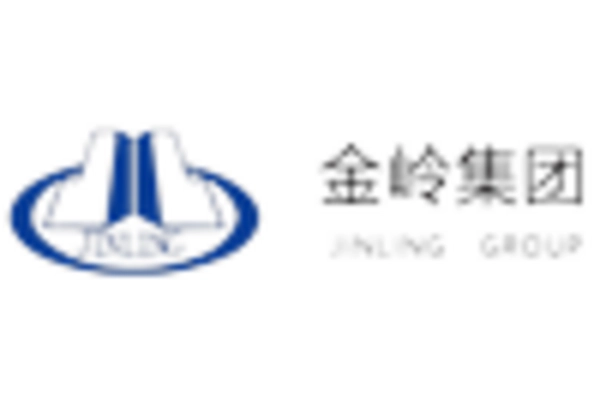Market Share
Dimethylacetamide Market Share Analysis
In the competitive landscape of the Dimethylacetamide (DMAc) Market, companies employ diverse strategies to establish a robust market presence and capture a significant share. DMAc, a versatile solvent with applications in various industries, demands a nuanced approach to cater to different customer needs. Here's a breakdown of key market share positioning strategies adopted by players in the Dimethylacetamide Market, presented in a concise pointer format:
Product Quality and Purity Focus:
Stringent Quality Control: Ensuring high-quality Dimethylacetamide through rigorous quality control measures enhances product reliability. Companies that adhere to industry quality standards and certifications build trust and credibility with customers.
High Purity Levels: Offering DMAc with high purity levels is essential, especially in applications where the solvent's quality directly impacts the performance of final products. Consistent purity levels contribute to market competitiveness.
Diverse Application-Specific Offerings:
Customized Formulations: Developing DMAc formulations tailored to specific industry needs enhances market penetration. Companies focus on providing solvent solutions suitable for diverse applications, including pharmaceuticals, textiles, and electronics, to meet unique customer requirements.
Versatility in Usage Recommendations: Offering guidance on the optimal usage of DMAc in different applications ensures customers derive maximum benefits. Technical support and recommendations contribute to customer satisfaction and loyalty.
Global Market Expansion:
Strategic Geographical Presence: Expanding market reach by strategically entering key geographical regions with high demand for DMAc is crucial. Companies consider regional variations in regulations, industry practices, and consumer preferences for effective market adaptation.
Local Partnerships: Forming partnerships with local distributors, manufacturers, or research institutions aids in navigating regional nuances efficiently. Local collaborations enhance market penetration and provide insights into specific market requirements.
Technological Advancements:
Advanced Production Technologies: Embracing innovative manufacturing technologies enhances efficiency, reduces production costs, and contributes to improved product quality. Continuous technological advancements reinforce competitiveness in the Dimethylacetamide Market.
Sustainability Integration: Adopting environmentally friendly production practices, such as the use of renewable energy sources or eco-friendly solvents, aligns with sustainability trends and enhances market appeal.
Cost Competitiveness and Operational Excellence:
Cost Optimization: Implementing cost-effective production processes and supply chain management helps companies maintain competitive pricing. Achieving cost competitiveness is crucial in a market where price considerations significantly influence customer choices.
Operational Efficiency: Striving for operational excellence through streamlined processes, energy efficiency, and waste reduction enhances overall production efficiency. Efficient operations contribute to maintaining competitive pricing and meeting market demands.
Sustainability Initiatives:
Eco-Friendly Manufacturing Practices: Responding to the growing demand for sustainable solutions, companies focus on adopting eco-friendly production practices for DMAc. This includes initiatives such as using renewable energy sources, reducing waste, and implementing green manufacturing technologies.
Bio-Based DMAc: Developing bio-based or renewable DMAc aligns with sustainability goals and appeals to environmentally conscious consumers. Companies investing in green alternatives position themselves as leaders in sustainable chemical manufacturing.
Educational Initiatives and Customer Support:
Technical Support Services: Offering technical support and expertise to customers, especially in the proper use of DMAc, enhances customer satisfaction. This level of support establishes the company as a valuable resource and contributes to market share growth.
Educational Content: Providing educational content about the benefits, uses, and safety considerations of DMAc helps raise awareness among potential customers. Companies actively engaging in educating the market contribute to increased understanding and adoption.
Strategic Pricing and Market Positioning:
Competitive Pricing Strategies: Implementing strategic pricing based on market analysis and competitor positioning helps companies maintain a competitive edge. Offering competitive prices without compromising on quality is essential in the Dimethylacetamide Market.
Value-Based Pricing: Communicating the value proposition of DMAc, such as its superior solvent properties or enhanced performance in specific applications, justifies pricing and positions the product as a premium offering.
Regulatory Compliance and Safety Measures:
Adherence to Regulations: Prioritizing regulatory compliance with standards such as REACH (Registration, Evaluation, Authorization, and Restriction of Chemicals) assures customers of the safety and quality of DMAc. Staying informed and compliant with evolving regulations is vital for market positioning.
Safety Certifications: Obtaining safety certifications and labels reinforces the credibility of DMAc as a safe and reliable solvent. Certifications from reputable organizations contribute to customer trust and enhance market competitiveness.


















Leave a Comment